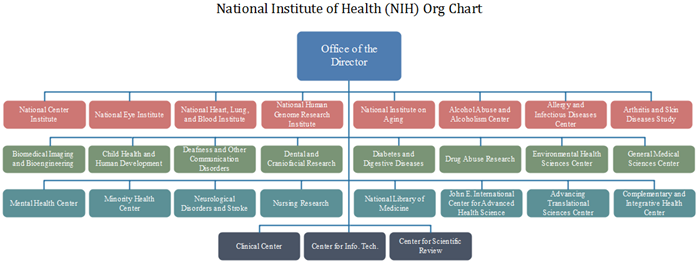The NIH organizational chart refers to the organizational structure of the U.S. National Institutes of Health. It belongs to the U.S. Department of Health and Human Services (HHS). The key missions of NIH are to look for basic knowledge about the nature and behavior of living systems in order to improve national health and prevent illness. You can find out more details of the NIH organizational chart by clicking on the chart below.
NIH Organizational Chart Key Divisions
The American National Institutes of Health has overall 27 sub-divisions named as Institutes and Centers. Each of the divisions has their own specific functions and duties for various researches programs. Some of the important sub-departments include:
The Office of the Director
This Director Office contains the Chief Director and a number of Deputy Directors. The Office is responsible for making NIH policies and managing different national health projects, events and more. Moreover, the Director of the institute offers leadership to constantly identify needs and requirements of the overall organization.
Data Science
Data science is another important topic in terms of the Institute’s daily tasks. The Data Science Center aims to explore the computational and quantitative sciences to analyze the influence and efficiency of medical subjects. What’s more, the Center cooperates with other national institutes to support researchers.
The Division of Program Coordination, Planning, and Strategic Initiatives (DPCPSI)
This part of the NIH organizational chart is mainly to identify scientific opportunities, help the public to know better about the health issues, develop and produce new scientific resources, plan and assist national programs, report to and cooperate with other federal agencies.
The NIH Office Of The Ombudsman
The Office offers support to national health communities members for lab and researches issues. Besides, the sub-division has many professionals with rich experience in solving organizational conflicts. For example, identify potential causes of disputes, facilitate internal communications between teams and staffs, or provide suggestions on leadership practices and organizational cultures.
How to Generate the NIH Organizational Chart?
Simply read this org chart creator guide for more information. Or feel free to use this easy org chart creator for more advanced settings and management of your business teams.

